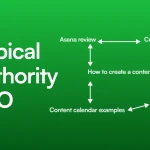Websites scream for attention today, and content floods the internet like a bursting dam. Amid this chaos, one goal rises above all—authority. Not just any authority, but topical authority. It is the kind that tells Google, “Hey, I know my stuff,” and the kind that tells users, “You can trust me.” And one smart, structured way to earn it is through a cluster content SEO strategy.
Let’s break it down and elevate your SEO in Melbourne.
What Is Topical Authority?
Topical authority is not about writing a hundred random blogs. It’s not about chasing every trending keyword like a headless chicken. It’s about owning a subject. When your website becomes the go-to source for everything on a topic, you achieve topical authority.
Google loves this. It rewards consistency and values depth. If your site becomes an encyclopedia on a niche, you stand tall in the search results.
Think of it this way. If someone writes 1 blog on electric cars, and another writes 50 insightful, interconnected pieces, who looks more credible? The answer is obvious.
The Cluster Content Model: A Game Plan
Enter the cluster content model. It’s not rocket science, but it’s smart science.
At its heart lies a pillar page. This is your main piece that covers the broad topic, and then come the cluster pages. These are supporting articles, and each zooms in on a subtopic. All cluster pages link back to the pillar. The pillar links out to the clusters. They form a strong web.
This interlinking structure tells Google, “This site gets it.” You’re not just scratching the surface. You’re digging deep.
Step 1: Choose Your Pillar Topic
Start with the broad, not vague. Broad.
For example, say your site is about nutrition. A strong pillar topic could be “Vegan Nutrition Basics” or “Keto Diet Explained”. Pick something evergreen. Something people search for constantly.
But avoid generic fluff. Don’t choose “Food.” That’s too wide. Stay focused but broad enough to branch out.
Use tools like Google Trends, AnswerThePublic, or Ahrefs. Hunt for demand. Find out what people crave to learn.
Step 2: Map Out the Cluster Topics
Now it gets interesting. Break the pillar topic into digestible pieces. Each piece becomes a cluster article.
Let’s stick with “Vegan Nutrition Basics” as your pillar. Your clusters could include:
- Vegan protein sources
- Vitamin B12 for vegans
- Iron-rich vegan foods
- Common vegan diet mistakes
- Vegan nutrition for athletes
Each of these deserves its own blog post. Each answers a specific question. Together, they build a kingdom of content.
Step 3: Write with Precision and Punch
Now comes the grind, but don’t panic. Writing doesn’t have to be a chore. It’s your chance to flex your knowledge muscles.
Start with the pillar page. Make it strong and thorough by covering the big picture. Use headers to organise sections. Add bullet points. Make it scannable.
Then write the clusters one by one. Treat each like a standalone article. But always link them back to the pillar. Always tie them together like puzzle pieces. Use natural language. Keep sentences short.
Make every word earn its place.
Step 4: Link Like a Pro
Internal linking is your secret weapon. It’s not just good for your SEO in Melbourne – but also for user experience.
At the end of each cluster article, add a link back to the pillar. Mid-article links work, too, but you need to sprinkle them naturally.
Do the reverse as well. On your pillar page, add links to all cluster pages, guiding readers. Keep them on your site. Make them bounce less and stay longer.
This linking tells search engines your content is connected.
Step 5: Optimise Each Piece Smartly
Don’t slap words on a page and call it a day. You must also optimise.
First, choose a main keyword for each article.
- Place it in the title.
- Use it in the first paragraph.
- Add it to the meta description.
- Sprinkle it in headers.
Then, use semantic keywords too. These are related phrases that make Google understand context now. Give it a buffet of related terms to munch on.
Lastly, add images, use alt text, and compress those images to avoid slow loads. Write compelling meta titles. Make every snippet pop.
Step 6: Update and Refresh
The internet doesn’t stand still. Your content shouldn’t either.
Every few months, revisit your clusters.
- Check for outdated info.
- Add new insights.
- Replace broken links.
- Expand on sections.
Update the pillar, too. Keep it alive. Add links to new clusters as you write more. Your topical authority grows over time, not overnight.
Real Results: Why This Works
This strategy is not theoretical fluff. It works. Websites that use cluster content climb rankings faster. They hold their ground longer. Why, because search engines trust depth. They want to serve users the best answers. A single strong article helps. But a full network of content? That’s unbeatable.
Topical authority keeps you ahead of algorithm updates. While others panic, your site stands firm. You’re not relying on hacks—you’re offering real value.
Final Thoughts
Topical authority isn’t about being loud. It’s about being thorough and showing up for every question your audience asks. The cluster content SEO strategy gives you a way to dominate your niche with clarity and confidence.
Start building smart clusters. And soon, when people search for answers in your field, it’s your website they’ll find—Not by accident, but by design. For more help, call the experts at Make My Website.







